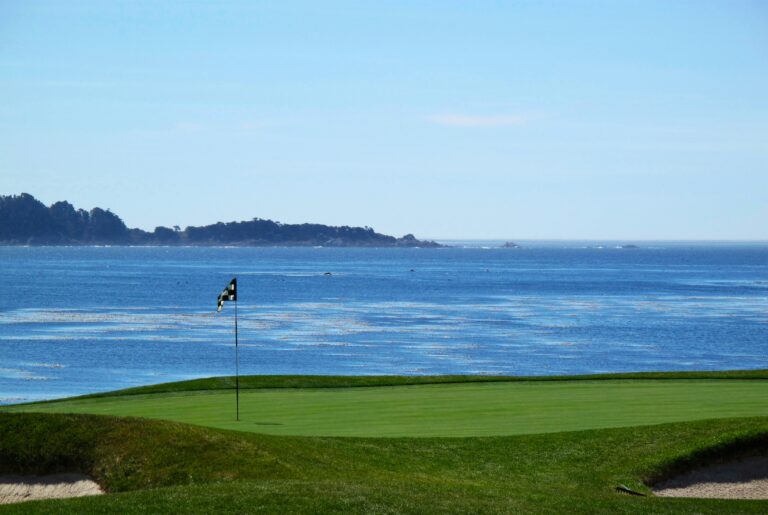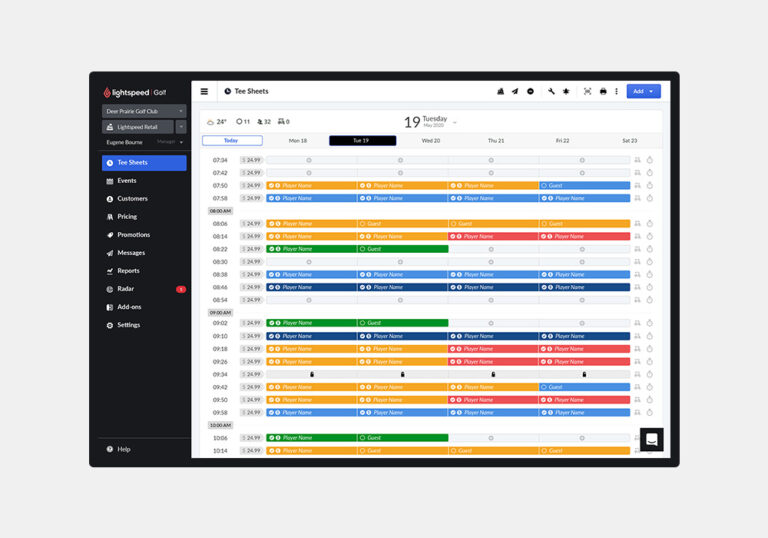Golf tournaments typically last between three and four days. Most professional events span four days, from Thursday to Sunday.
Golf enthusiasts often mark their calendars for the excitement of tournament season, where the serene greens come alive with the buzz of competition. These events showcase the best in the sport, offering a blend of strategy, skill, and suspense that keeps fans riveted.
The standard four-day stretch allows for a full field of golfers to compete in the initial rounds, with a cut typically occurring after the second day to narrow down the contenders. This structure not only tests the endurance and consistency of the players but also provides ample opportunity for spectators to witness a wide range of talents. From the first tee-off to the final putt, golf tournaments offer a compelling narrative that unfolds over several days, culminating in a weekend where champions rise and memorable moments are etched into the sport’s history.
Contents
- 1 Teeing Off: Golf Tournament Basics
- 2 The Duration Of Different Golf Events
- 3 Factors Affecting Golf Tournament Length
- 4 Day-by-day Breakdown
- 5 Cut Policy And Its Impact
- 6 The Final Round: Climax Of The Tournament
- 7 Beyond The 18th Hole: Post-tournament Activities
- 8 Planning Your Visit To A Golf Tournament
- 9 Frequently Asked Questions
- 10 Conclusion
Teeing Off: Golf Tournament Basics
Golf tournaments vary in length and structure. Most last between three and four days. Each day, players complete one round of 18 holes. Let’s dive into the details of professional golf events and the different types of tournaments.
The Structure Of Professional Golf Events
Professional golf tournaments are meticulously organized. The main types are stroke play and match play. In stroke play, the golfer with the fewest total strokes wins. In match play, players compete head-to-head on each hole.
| Type of Play | Description |
|---|---|
| Stroke Play | Total strokes counted over rounds |
| Match Play | Head-to-head on each hole |
Major tournaments, like The Masters, use stroke play over four days.
Categories Of Golf Tournaments
- Majors: These are the most prestigious. Examples include The Masters and The Open Championship.
- National Opens: These are hosted by various countries, like the U.S. Open and the Australian Open.
- Charity Events: These tournaments raise money for causes. They are less competitive.
- Corporate Events: Businesses host these for networking and team building.
Golf tournaments bring players and fans together from around the world. They showcase skill, strategy, and sportsmanship.
The Duration Of Different Golf Events
The Duration of Different Golf Events varies significantly. Golf tournaments span days or just a few hours. Understand these differences to plan your viewing or participation.
Majors And Weekend Classics
Golf majors are the longest and most prestigious. Weekend classics usually stretch over four days, from Thursday to Sunday. Players compete in rounds, with the final day reserved for top performers.
- Thursday to Sunday: Main competition days
- 18 holes played each day
- Cut after two days to narrow the field
Notable majors include:
| Major | Month |
|---|---|
| The Masters | April |
| US Open | June |
| The Open Championship | July |
| PGA Championship | May |
Mid-week Competitions
Mid-week events are shorter, often tailored for club players. These competitions can be single-day events or span a couple of days.
- 9 to 18 holes: Common formats
- 1 to 2 days: Typical duration
- Evening start times: For after-work play
Examples include:
- Local club tournaments
- Business league matches
- Charity fundraising events
Factors Affecting Golf Tournament Length
Golf tournaments capture the imagination with the thrill of competition. Yet, their lengths vary widely. Several factors influence the duration of these events. Understanding these factors helps fans plan their viewing schedules. Let’s explore key elements affecting how long golf enthusiasts will be on the edge of their seats.
Course Difficulty And Layout
The complexity of a golf course plays a significant role in tournament length. Tougher courses challenge even seasoned players, leading to longer rounds. Courses with longer fairways, numerous hazards, and undulating greens demand precision and careful strategy. Players may take more time planning their shots, thus extending the tournament.
- Par of the course: Higher par usually means more shots, hence longer play.
- Hazards: Water and bunkers can slow down the pace.
- Green complexity: Courses with tricky greens require more time for putting.
Weather Conditions And Delays
Weather is a wild card in the world of golf. Sunny skies can turn to rain, causing delays and rescheduling. Lightning poses a safety risk, leading to immediate suspension of play. Wind affects ball trajectory, making shots more challenging and time-consuming.
| Weather Condition | Effect on Tournament |
|---|---|
| Rain | Delays due to wet course conditions |
| Lightning | Play suspension for safety reasons |
| Wind | Longer time for shot planning and execution |
Delays can push a tournament’s schedule to the next day. Extended play affects player endurance and can change the competitive landscape. Spectators and broadcasters must adjust their plans to accommodate these changes.
Day-by-day Breakdown
Understanding the timeline of golf tournaments enhances the viewing experience. Each day brings new challenges and excitement. Let’s explore how these events unfold from practice rounds to the final putt.
Practice Rounds And Pro-ams
Golf tournaments kick off with practice rounds. These are non-competitive days. Golfers get familiar with the course. They check the greens and plan their strategies. Often, they play informal games.
Pro-Ams pair professional golfers with amateur players. It’s a fun event. Fans enjoy watching their favorites alongside celebrities and business leaders. These rounds usually take place in the days leading up to the main event.
Main Event: Round Progression
The main event spans four days, from Thursday to Sunday. Each day, golfers play one round of 18 holes. Their scores add up each day.
| Day | Event |
|---|---|
| Thursday | First Round |
| Friday | Second Round |
| Saturday | Third Round |
| Sunday | Final Round |
After the second round, there’s a ‘cut’. This means only the top scorers continue to the next rounds. The weekend rounds decide the winner. Each shot is crucial. Tensions rise as players aim for the top spot.
Cut Policy And Its Impact
The cut policy in golf tournaments is a pivotal point. It not only shapes the competition but also affects the event’s length. Let’s delve into the cut’s significance and its effects on the tournament’s duration.
Understanding The Cut
In most golf tournaments, the cut represents a score line. Players who score above this line continue playing. Others must stop after two rounds. The cut ensures only top-performing players complete the event. It maintains a high level of play throughout the tournament.
Implications For Tournament Duration
The cut policy can alter a tournament’s timeline significantly. With fewer players, rounds progress faster. This streamlines the event, allowing for a quicker conclusion. The cut ensures efficiency and maintains spectator interest. It highlights the competition’s intensity as players strive to make the cut.
The Final Round: Climax Of The Tournament
The final round of a golf tournament is where champions emerge. It’s the day when the week’s efforts culminate in one last push for glory. Tension fills the air as leaders and chasers tee off, each vying for a spot in the trophy presentation. Thrilling shots, critical putts, and the roar of the crowd define this ultimate round.
Leading Up To The Trophy Presentation
The path to the trophy is lined with crucial moments. Players must maintain focus and execute their game plan flawlessly. Fans witness spectacular drives and strategic plays. The leaderboard shifts with each hole, keeping everyone on the edge of their seats.
- Early birdies set the tone for contenders.
- Meticulous course management is vital.
- Consistency is key under mounting pressure.
As the round progresses, anticipation builds. The final putt on the 18th green signifies the end of the journey. The crowd applauds as the winner raises their arms in victory. The presentation ceremony is a moment of joy and relief for the champion.
Sudden Death And Playoffs
If players are tied, the tournament enters a playoff. Sudden death determines the winner. Each shot is critical, and the atmosphere is electric. Golfers must stay calm and precise. The first to gain an advantage often seizes the trophy.
- Playoff holes are pre-determined by the tournament.
- The pressure intensifies with each swing.
- Crowds gather to witness the decisive moments.
Victory in a playoff is sweet. It is a testament to the golfer’s skill and mental strength. The champion’s name is etched in history. They lift the trophy high, their triumph a memory for the ages.
Beyond The 18th Hole: Post-tournament Activities
The thrill of golf tournaments extends beyond the final putt on the 18th hole. Post-tournament activities offer fans and players alike a chance to revel in the event’s highlights. From trophy presentations to engaging with the press, the end of play marks the beginning of celebrations and responsibilities.
Ceremonies And Celebrations
As the last ball drops into the cup, players and spectators shift their attention to the award ceremonies. These events are not just formalities; they are vibrant celebrations of skill, dedication, and sportsmanship. Here’s what typically unfolds:
- Trophy Presentation: The winner receives the coveted trophy amidst cheers.
- Speeches: Winners and organizers share their thoughts and gratitude.
- Photo Sessions: Winners pose with their trophies, capturing memories.
- Champagne Showers: Often, winners are doused in champagne, marking their victory.
Media Engagements
Once the on-field celebrations conclude, players engage with the media. This is crucial for sharing their experiences and maintaining public relations. Key media engagements include:
- Press Conferences: Winners answer questions, providing insights into their strategies.
- Interviews: Exclusive one-on-one sessions with the media delve deeper into the players’ perspectives.
- Social Media Updates: Players and organizers post updates, extending the tournament’s reach.
These activities ensure that the excitement of the tournament lives on, even after the final scores are tallied.
Planning Your Visit To A Golf Tournament
Golf tournaments offer excitement and entertainment for fans of all ages. A successful visit requires knowledge of the event’s structure and the best times to attend. This guide will help you plan your trip and ensure you get the most out of your golf tournament experience.
Best Days To Attend
Golf tournaments typically span several days, starting with practice rounds and concluding with the championship round. The opening day offers a relaxed atmosphere, while the final day is filled with intense competition and drama.
- Practice Rounds: Players are approachable; autograph opportunities are plenty.
- Mid-Tournament: Crowds are smaller; follow favorite golfers easily.
- Championship Day: Excitement peaks; witness history in the making.
Maximizing The Experience
Attending a golf tournament is more than just watching the game. It’s about enjoying the venue, the food, and the community. Here’s how to make the most of your visit:
| Tip | Details |
|---|---|
| Arrive Early | Beat the crowds, find good parking, and choose the best viewing spots. |
| Plan Your Spots | Identify key holes and locations to watch the action unfold. |
| Stay Hydrated | Bring a refillable water bottle to stay hydrated throughout the day. |
| Wear Comfortable Shoes | Expect to walk a lot; comfortable footwear is a must. |
| Check the Weather | Be prepared with sunscreen, hats, or rain gear, depending on the forecast. |
Frequently Asked Questions
How Long Is A Golf Tournament Per Day?
A typical golf tournament spans four days, with each day’s play lasting about 4-6 hours.
How Long Does A Round Of Golf Take In A Tournament?
A typical round of golf in a tournament usually takes around 4 to 6 hours. This duration can vary based on the number of players and course difficulty.
How Many Rounds Are In A Golf Tournament?
A standard golf tournament typically consists of four rounds. These rounds are usually played over four consecutive days.
How Long Does A Disc Golf Tournament Last?
A disc golf tournament typically lasts one to four days, depending on the event size and format.
Conclusion
Understanding the duration of golf tournaments helps fans and players plan accordingly. From weekend-long amateur events to four-day professional majors, the time frame varies. Remember, weather and play style influence the length too. Keep this guide in mind for your next golf adventure.
Enjoy the game and the excitement it brings, regardless of the tournament span.





